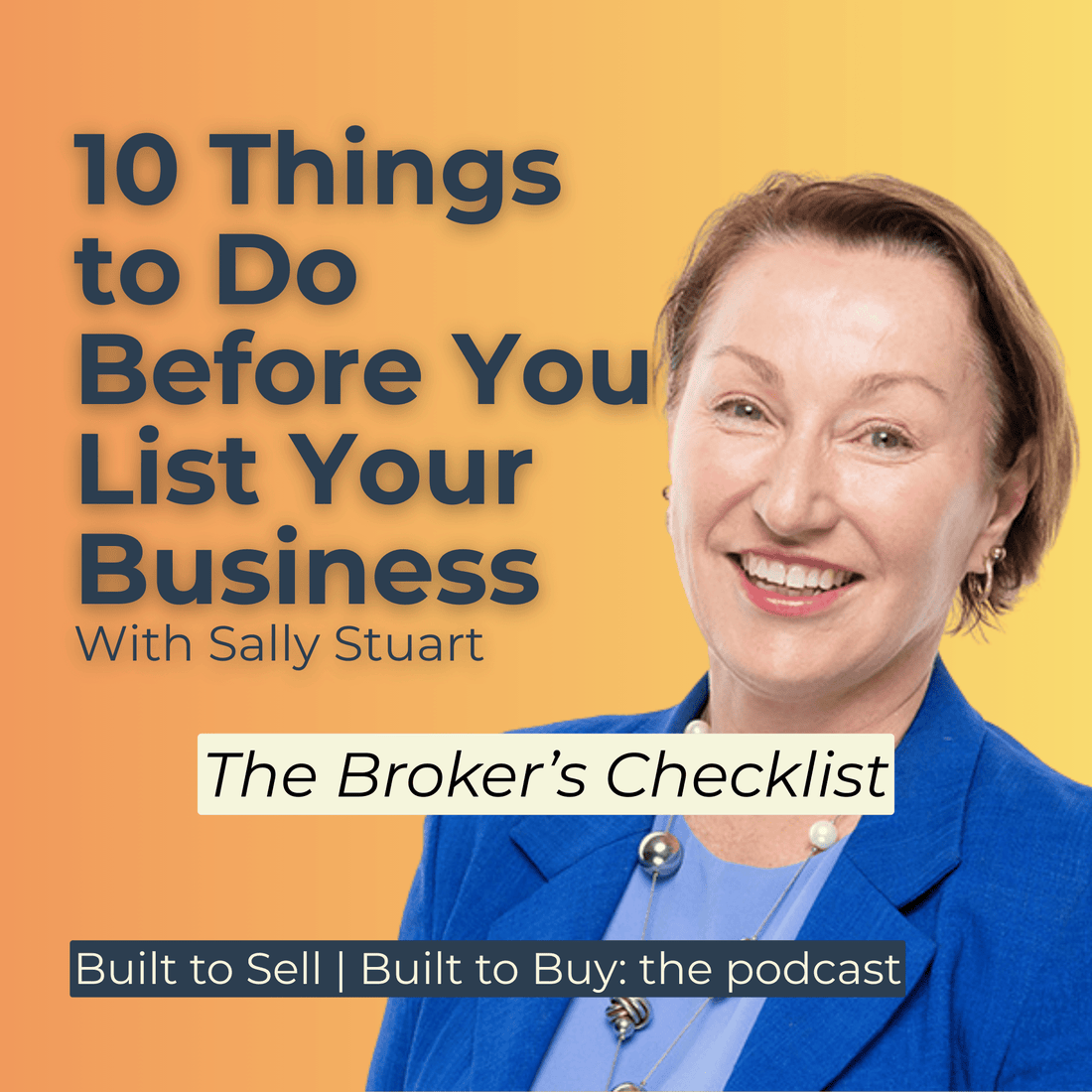
10 Things to Do Before You Sell Your Business: The Ultimate Broker + Coach Checklist
Share
Selling your business is a strategic process. Prepare early, reduce buyer risk, and make your company irresistible to the right buyer with this combined checklist from business coach Sam Penny and specialist broker Sally Stuart.
Built to Sell | Built to BuyWatch the Episode
Prefer video? Watch the full conversation with Sally Stuart where we compare our top 10 and unpack the steps that really move the needle on valuation.
Contents
- Define Your Why and Develop a Sales Plan
- Get a Professional Valuation
- Clean Up Your Financials
- Ensure Legal and Regulatory Compliance
- Document Your Systems and Processes (SOPs)
- Engage the Right Advisers Early
- Create Compelling Marketing Materials
- Identify and Resolve Key Risks
- Remove Owner Dependency
- Plan for Employee and Customer Transition
Selling your business is one of the most significant financial and emotional decisions you’ll ever make. Whether you’ve built your company over decades or just a few intense years, you only get one chance to maximise the value of your sale.
Yet too many owners treat selling as a quick transaction instead of what it truly is — a strategic process that takes months or even years of preparation. That’s why in this article, I’ve combined my own business coach’s perspective with the broker’s insights of Sally Stuart, one of Australia’s leading specialists in healthcare, allied health, aged care, and NDIS business sales.
The result? The Ultimate 10 Things to Do Before You Sell Your Business Checklist — a clear, actionable blueprint that will help you prepare your business for market, boost your valuation, and make it irresistible to the right buyer.
Why Preparing Early Pays Off
If there’s one takeaway from working with thousands of business owners, it’s this: the businesses that achieve premium sale prices are the ones that start preparing years in advance.
When you take the time to:
- Optimise your profitability
- Reduce buyer risk
-
Create a smooth transition plan
…you’re not just increasing your valuation; you’re expanding your pool of potential buyers.
Preparation is also about avoiding red flags that could kill a deal. Buyers (and their accountants, lawyers, and financiers) are looking for confidence. Anything that erodes that confidence — messy financials, unclear contracts, key person dependencies — can lower offers or stop a sale in its tracks.
1) Define Your Why and Develop a Sales Plan
Buyers and their advisers will ask why you are selling. Your answer shapes confidence in the deal. Write your reasons down, decide what you want to do post-sale, and build a timeline that allows you to prepare properly. For most owners, that means 18 months to 3 years of deliberate preparation.
- Clarify your goal: retirement, new venture, scale via acquisition, or lifestyle change.
- Talk to your financial planner about capital gains tax and retirement funding.
- Set milestones for improving profit, systems, and documentation ahead of listing.
Preparation is not about delay. It is about making your business genuinely attractive to own.
2) Get a Professional Valuation
What you think your business is worth is not enough. Most steady-state businesses are valued on EBITDA × multiple. The EBITDA reflects performance to date. The multiple reflects risk and future confidence. Understanding both lets you set realistic expectations and target the drivers that actually lift value.
Action steps
- Engage a qualified valuer or experienced broker for a market appraisal.
- Calculate normalised EBITDA and understand industry multiples.
- Map the weighting factors that influence your multiple: age of business, location, risk profile, buyer demand, contracts, churn, and concentration.
3) Clean Up Your Financials
Financial transparency is non-negotiable. Remove personal expenses, standardise reporting, and avoid major structural shifts just before sale that make year-to-year comparisons messy for buyers, accountants, and banks.
- Normalise your accounts to reflect true profitability.
- Provide consistent, comparable financials for at least three years.
- Tighten stock control, debtors, and cashflow reporting to reduce friction in due diligence.
4) Ensure Legal and Regulatory Compliance
Gaps in compliance can stall or sink deals. Review contracts, licences, permits, and registrations well before you come to market. Clear encumbrances and resolve disputes early.
- Put current, transferable agreements in place for employees, contractors, suppliers, and landlords.
- Verify licences, permits, certifications, and PPSR status.
- Avoid end-of-year slowdowns by starting paperwork early.
5) Document Your Systems and Processes (SOPs)
Standard Operating Procedures reduce risk, speed onboarding, and make your results repeatable. If a task happens more than once a week, it belongs in an SOP. Store them in an accessible, version-controlled system and keep them current.
- Write SOPs for operations, sales, finance, compliance, and customer care.
- Create role handbooks and training checklists for all key positions.
- Test SOPs by onboarding a new team member or by taking leave and fixing gaps that appear.
6) Engage the Right Advisers Early
Specialists save time and protect value. Choose people who work in business sales weekly, not occasionally.
- Broker: Industry-experienced, transparent, and communicative.
- Lawyer: Commercial specialist for share/asset sales and contracts.
- Accountant: Structuring advice, normalisations, and tax planning.
- Coach: Improve EBITDA, reduce risk, and lift the multiple ahead of sale.
7) Create Compelling Marketing Materials
A strong Information Memorandum (IM) and concise pitch deck help buyers see the opportunity fast. Tell a clear story of the business today and where it can go under new ownership.
- Include history, model, financial summary, SWOT, team, systems, contracts, risks, and opportunities.
- Articulate your core values; values alignment improves cultural fit and retention.
- Use clean design and make data easy to digest at a glance.
8) Identify and Resolve Key Risks
Red flags kill deals. Be upfront, fix what you can, and document how remaining risks are mitigated.
- Key person dependency and succession plans.
- Supplier, customer, and lease security with transfer clauses where possible.
- Cybersecurity, privacy, and data protection training and controls.
- Concentration risks and how you are diversifying revenue.
9) Remove Owner Dependency
A business that runs without the owner invites a wider pool of buyers, including investors. Delegate leadership, elevate managers, and gradually step back from the day to day.
- Hand off approvals, relationships, and knowledge to documented roles.
- Take extended leave to stress-test independence and fix gaps.
- Recast your role as strategic adviser during transition, not operational bottleneck.
10) Plan for Employee and Customer Transition
Protect momentum and goodwill. Time your announcements and support the team through change. Where possible, sell to a buyer who aligns with your values to smooth handover and retention.
- Draft a communication plan for staff and key customers.
- Offer retention bonuses or pathways for key people.
- Co-create a first-100-days plan with the buyer for a stable transition.
The Ultimate 10 Things to Do Before You Sell Your Business Checklist
Work through each item and tick them off as you go. This combines the broker’s view with the coach’s playbook so you can prepare thoroughly and maximise value.
Define your why and set a sales plan
Write your reason to sell, decide post-sale goals, align with your financial planner, and set a realistic 18–36 month timeline.
Get a professional valuation
Obtain a market appraisal, calculate normalised EBITDA, understand multiples and weighting factors, and map value gaps to address.
Clean up your financials
Remove personal expenses, standardise reporting, and present at least three consistent years. Tighten stock, debtors, and cashflow discipline.
Ensure legal and regulatory compliance
Current contracts for staff, contractors, suppliers, and the lease. Licences, permits, certifications, and PPSR checked and clear of encumbrances.
Document systems and processes (SOPs)
Write SOPs for recurring tasks, create role handbooks, store centrally, and train the team. Test by onboarding and during planned leave.
Engage the right advisers early
Broker with industry expertise, commercial lawyer, proactive accountant, and a coach to drive EBITDA and multiple uplift before sale.
Create compelling marketing materials
Professional IM and pitch deck, clear financial summaries, SWOT with actions, core values, and a crisp narrative of future potential.
Identify and resolve key risks
Key person succession, supplier and customer security, lease certainty, cybersecurity controls, and revenue concentration mitigation.
Remove owner dependency
Delegate leadership, distribute relationships, and step back from operations. Prove the business runs smoothly in your absence.
Plan employee and customer transition
Retention incentives, timed announcements, values-aligned buyer, and a first-100-days handover plan co-authored with the acquirer.
Prefer to listen on your favourite app?
About the guests
Sally Stuart is a specialist business broker working with doctors, dentists, allied health, aged care and NDIS businesses across Australia.
Connect on LinkedIn
Visit her Business Broker Page
Sam Penny helps business owners get exit-ready, lift valuation drivers, and close smarter deals through 90-day sprints and hands-on coaching.
